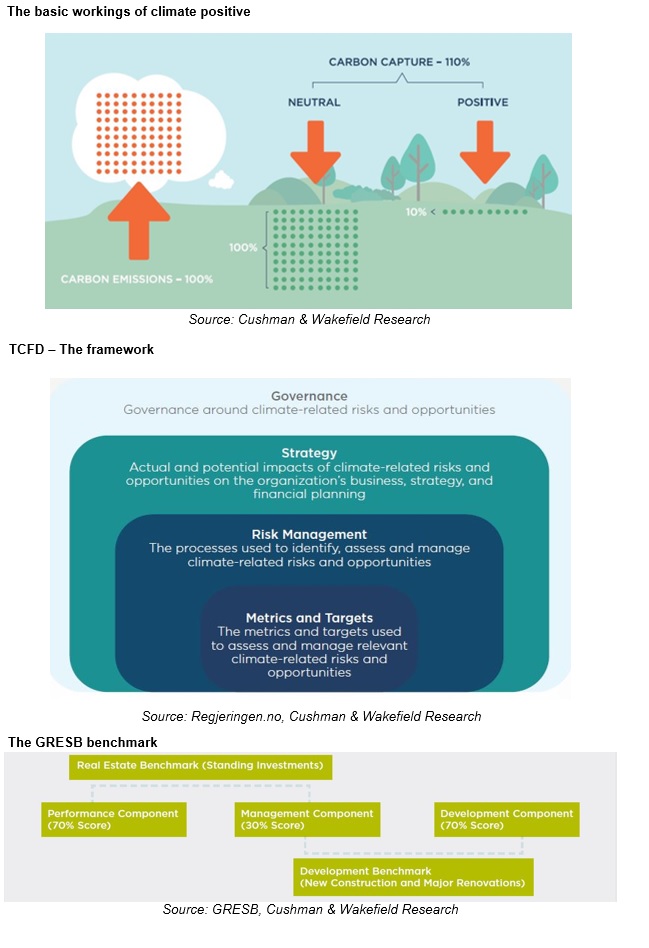
What is climate positive?
Climate positive is an initiative that goes above and beyond. Here, net zero carbon emissions are achieved and surpassed whereby an environmental benefit is produced by eradicating additional carbon dioxide (CO2) from the atmosphere.
Buildings can realise climate-positive results in a number of ways, including:
- The choice of building location;
- The choice of building design and energy modelling;
- The usage of eco-friendly, low carbon, reused or recycled materials;
- The minimisation of material and operational wastage;
- The maximisation of structural efficiency;
- The use of building insulation;
- The regular maintenance of plant, machinery, sensors and devices and ensuring these systems have the latest technology;
- The use of greenhouse gas (GHG) emissions reduction systems;
- The use of renewable energy;
- The use of intelligent energy management systems;
- The maximisation of water use reduction, and;
- The re-use/renewal of the building upon current-use obsolescence.
Rating and benchmarking systems that are used to positively prove how sustainable real estate is and how sustainable an enterprise is, (and if any are able to achieve a climate-positive outcome), are many. Two systems that have gained market traction recently, however, are:
1. At the enterprise level � The Task Force on Climate-Related Financial Disclosures (TCFD).
The TCFD system allows enterprises to recognise and disclose climate-related risks and opportunities so as to enable informed decision making for investors, lenders, insurers and other related participants. The use of the TCFD system aids enterprises as they ascertain and handle physical and transition climate risks.
2. At the real estate level � The Global Real Estate Sustainability Benchmark (GRESB).
GRESB assesses the environmental, social and governance (ESG) performance of real assets, which
include real estate. In terms of environmental issues, the rating system encourages enterprises to reduce GHG emissions, lessen wastage, and conserve water and energy.
Today, these two systems have gained solid market traction and are widely used by many enterprises to help them achieve their sustainability goals.
Shaun Brodie, Head of Occupier Research, Greater China, Cushman & Wakefield said, “Cushman & Wakefield aims to reach net zero emissions across its entire value chain by 2050. In the context of the ‘carbon peak and carbon neutrality’ objective in China and global warming, there are still some people, enterprises, and localities that may not have the resources or plans in place to lessen their individual carbon footprint, to go carbon negative or even to strive for a climate positive goal. By understanding the concept of climate positive and learning how to implement some of the related ‘green’ rating and benchmarking systems these groups of people and organisations will be best placed to achieve sustainability targets that actually add positive benefit value to the environment now and into the future.”
Alton Wong, Co-head of Sustainability Services Platform, Greater China, Head of Advisory Services, Valuation & Advisory Services, Greater China, Cushman & Wakefield, said, “Since the COP26 meeting in Glasgow in 2021, one significant development has been the formation of a new International Sustainability Standards Board (ISSB) to develop, in the public interest, an all-embracing global baseline for high-quality disclosure standards to meet the needs of investors. Once used, it will greatly affect the future development of Chinese enterprises.”
Corrine Chen, Acting Co-head of Sustainability Services Platform, Greater China, Acting Head of Project & Development Services, West China, Cushman & Wakefield, said, “The built environment can reduce its emissions by going net zero, but some real estate enterprises today are looking to go climate positive, an initiative that goes above and beyond. Cushman & Wakefield is committed to helping enterprises achieve their sustainability goals.”
Please click here to download the full reportHashtag: #Cushman&Wakefield
About Cushman & Wakefield
Cushman & Wakefield (NYSE: CWK) is a leading global real estate services firm that delivers exceptional value for real estate occupiers and owners. Cushman & Wakefield is among the largest real estate services firms with approximately 50,000 employees in over 400 offices and 60 countries. Across Greater China, 23 offices are servicing the local market. The company won four of the top awards in the Euromoney Survey 2017, 2018 and 2020 in the categories of Overall, Agency Letting/Sales, Valuation and Research in China. In 2021, the firm had revenue of $9.4 billion across core services of property, facilities and project management, leasing, capital markets, valuation, and other services. To learn more, visit ![]() www.cushmanwakefield.com.hk or follow us on LinkedIn (
www.cushmanwakefield.com.hk or follow us on LinkedIn (![]() https://www.linkedin.com/company/cushman-&-wakefield-greater-china).
https://www.linkedin.com/company/cushman-&-wakefield-greater-china).






